
Goldshore Announces Strong Initial Drilling Results from the East Coldstream Deposit 13 Kilometers Northeast of Moss Lake

Goldshore Resources Inc. (TSX-V: GSHR) (OTCQB: GSHRF) (FWB: 8X00) is pleased to announce assay results from eight holes drilled to test gold mineralization at the East Coldstream deposit at the Moss Lake Project in Northwest Ontario, Canada.
Highlights:
- Results for eight holes, drilled to better define the gold mineralization of the East Coldstream deposit, have confirmed three broad lenses of gold mineralization within the two main shear zones with best intercepts of:
- 23m @ 1.34 g/t Au from 244m depth in CED-22-004, including
- 7.35m @ 3.77 g/t Au from 254.2m
- 17.3m @ 1.55 g/t Au from 487m depth in CED-22-005
- 20m @ 1.15 g/t Au from 402m depth in CED-22-006
- 26m @ 1.66 g/t Au from 451m, including
- 7.9m @ 4.20 g/t Au from 465m
- 25.7m @ 2.07 g/t Au from 488m
- 37.05m @ 1.54 g/t Au from 209.3m depth in CED-22-007
- 27.9m @ 1.14 g/t Au from 387m depth in CED-22-008, including
- 13m @ 2.14 g/t Au from 401m
- 23m @ 1.34 g/t Au from 244m depth in CED-22-004, including
- The better intercepts are all centered around five high-grade gold zones of mineralized breccia, including:
- 1.05m @ 15.8 g/t Au from 257.95m depth in CED-22-004
- 0.9m @ 14.3 g/t Au from 472m depth in CED-22-006, and
- 0.65m @ 13.5 g/t Au from 502m
- 0.85m @ 10.6 g/t Au from 244.35m depth in CED-22-007, and
0.4m @ 12.6 g/t Au from 418m
President and CEO Brett Richards stated:
“These first results are extremely encouraging and significant to the overarching strategy of developing a secondary resource to Moss Lake. This will provide optionality that can only help improve the new PEA study next year. The results also point to a second significant project within our land package, which highlights the potential for further discoveries.”
Technical Overview
Figure 1 shows the location of the East Coldstream deposit relative to the Moss Lake deposit and the Archean Shebandowan Greenstone Belt. Table 1 and Figure 3 show the significant intercepts. Table 2 and Figure 2 show the drill hole locations. Figures 4 and 5 show a cross section through CED-22-006 and long section along the southern zone, respectively.

Figure 1: Location map showing East Coldstream relative to Moss Lake

Figure 2: Drill plan showing drill holes (long section is Figure 5)

Figure 3: Drill plan showing best of several +1 g/t Au intercepts
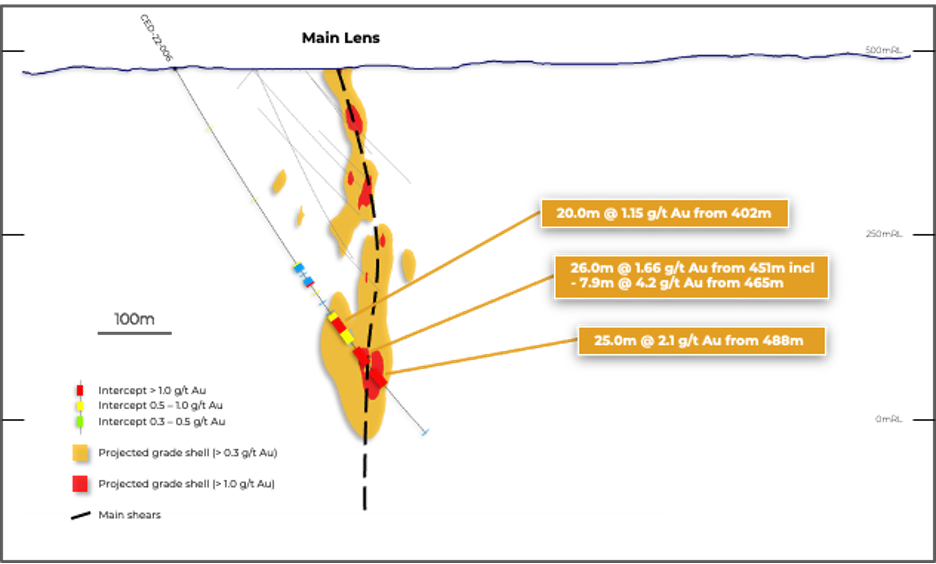
Figure 4: Drill section through CED-22-006 and the Main Lens
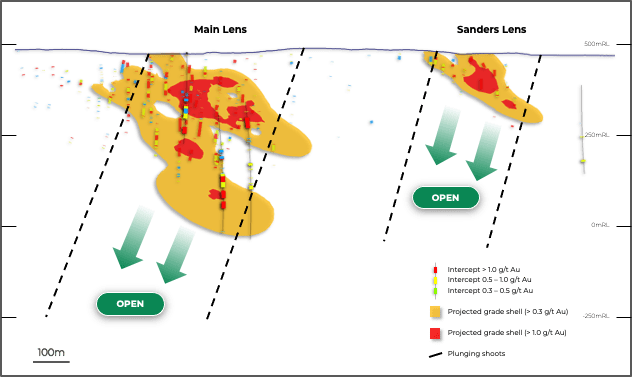
Figure 5: Long section through the Main and Sanders Lenses
Table 1: Significant downhole gold intercepts
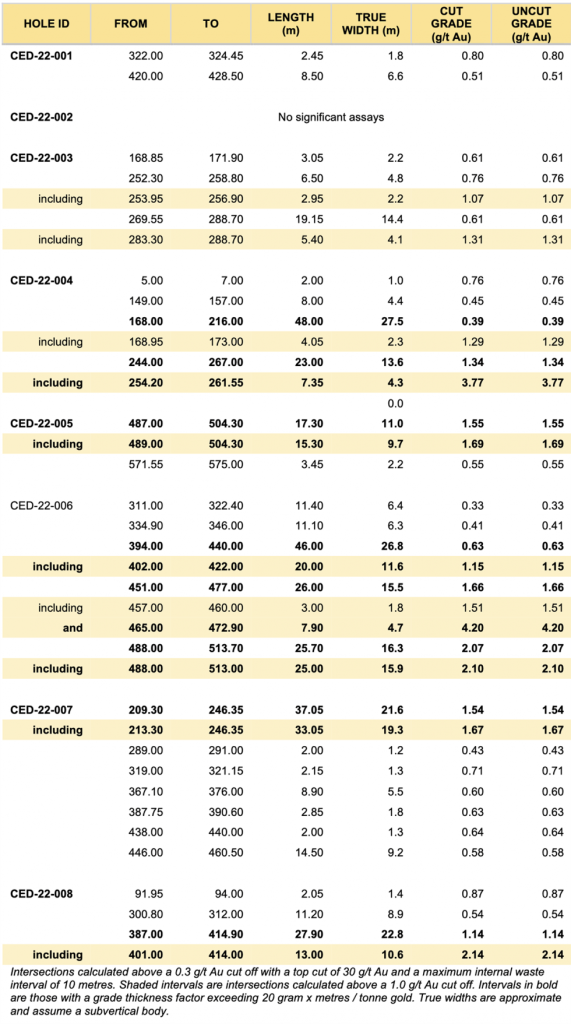
Table 2: Location of drill holes in this press release
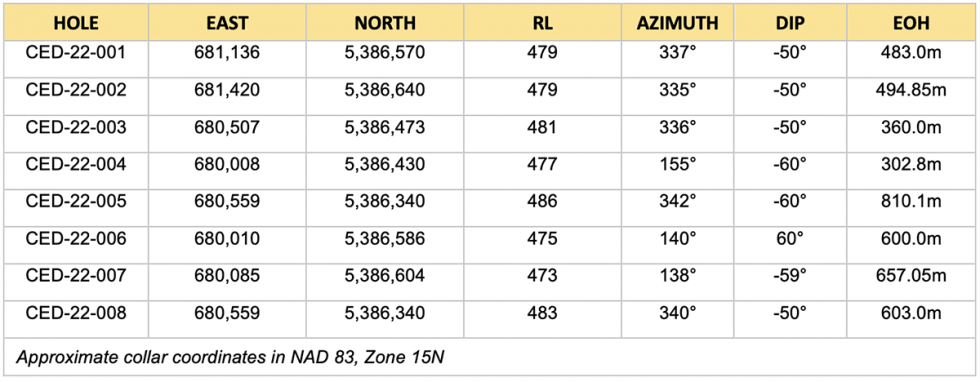
Results have been received for eight of the initial 17 holes in the first pass drilling program at East Coldstream. These drillholes tested the existing mineralized lenses, as well as possible eastern and down-dip extensions.
Our work on the mineralization paragenesis and its structural controls has shown that gold mineralization is related to pervasive silica-hematite alteration and sulfide veining associated with an extensional brecciation event following extensive shearing. At the deposit scale, this formed three lenticular bodies within two main shear zones (Figure 1). Based on structural measurements from oriented core, each body has a steeply west-dipping plunge and a gently east-pitching stretching lineation that creates an internal fabric to mineralization (Figure 4). This structural control creates the potential for additional high-grade mineralization to occur below the shallowly drilled portions of the shears zones such as encountered in CED-22-007.
CED-22-001 and -002 tested a similar geophysical feature to the east of the East Coldstream deposit. CED-22-001 was drilled closest to East Coldstream and encountered narrow zones of mineralization, while CED-22-002 was drilled 300 meters further east and did not encounter significant results. This sterilizes the immediate extension, but given the lenticular geometry of mineralization, leaves open the prospectively of the structure further to the east.
CED-22-003 and -004 drilled the North and Main Lenses, respectively. Both holes intersected broad low-grade mineralized zones, including 19.15m @ 0.61 g/t Au from 269.55m in CED-22-003; and 48m @ 0.39 g/t Au from 168m and 23m @ 1.34 g/t Au in CED-22-004.
Holes CED-22-005 to -008 tested down plunge extensions of the known mineralization. All holes intersected variable widths of higher grade mineralization, including 17.3m @ 1.55 g/t Au from 487m in CED-22-005; 20.0m @ 1.15 g/t Au from 402m, 26.0m @ 1.66 g/t Au from 451m, and 25.7m @ 2.07 g/t Au from 488m in CED-22-006; 37.05m @ 1.54 g/t Au from 209.3m in CED-22-007; and 27.9m @ 1.14 g/t Au from 387m in CED-22-008.
Pete Flindell, VP Exploration for Goldshore, said:
“Our analysis of drill results at East Coldstream confirms the two parallel shear zones that were modelled in the past. The recognition of a greater structural control within these shears has led to the modelling of three steeply dipping lenticular shoots that remain open at depth. A gently dipping internal fabric suggests that mineralization is focused within discrete structures that may allow us to model a higher-grade resource than exists in the historic estimate.”
Analytical and QA/QC Procedures
All samples were sent to ALS Geochemistry in Thunder Bay for preparation and analysis was performed in the ALS Vancouver analytical facility. ALS is accredited by the Standards Council of Canada (SCC) for the Accreditation of Mineral Analysis Testing Laboratories and CAN-P-4E ISO/IEC 17025. Samples were analyzed for gold via fire assay with an AA finish (“Au-AA23”) and 48 pathfinder elements via ICP-MS after four-acid digestion (“ME-MS61”). Samples that assayed over 10 ppm Au were re-run via fire assay with a gravimetric finish (“Au-GRA21”).
In addition to ALS quality assurance / quality control protocols, Goldshore has implemented a quality control program for all samples collected through the drilling program. The quality control program was designed by a qualified and independent third party, with a focus on the quality of analytical results for gold. Analytical results are received, imported to our secure on-line database and evaluated to meet our established guidelines to ensure that all sample batches pass industry best practice for analytical quality control. Certified reference materials are considered acceptable if values returned are within three standard deviations of the certified value reported by the manufacture of the material. In addition to the certified reference material, certified blank material is included in the sample stream to monitor contamination during sample preparation. Blank material results are assessed based on the returned gold result being less than ten times the quoted lower detection limit of the analytical method. The results of the on-going analytical quality control program are evaluated and reported to Goldshore by Orix Geoscience Inc.
About Goldshore
Goldshore is an emerging junior gold development company, and owns the Moss Lake Gold Project located in Ontario. Wesdome Gold Mines Ltd. is currently a large shareholder of Goldshore with an approximate 27% equity position in the Company. Well-financed and supported by an industry-leading management group, board of directors and advisory board, Goldshore is positioned to advance the Moss Lake Gold Project through the next stages of exploration and development.
About the Moss Lake Gold Project
The Moss Lake Gold Project is located approximately 100 km west of the city of Thunder Bay, Ontario. It is accessed via Highway 11 which passes within 1 km of the property boundary to the north. The Moss Lake Gold Project covers 14,292 hectares and consists of 282 unpatented and patented mining claims.
The Moss Lake Gold Project hosts a number of gold and base metal rich deposits including the Moss Lake Deposit, the East Coldstream Deposit (Table 3), the historically producing North Coldstream Mine (Table 4), and the Hamlin Zone, all of which occur over a mineralized trend exceeding 20 km in length. A historical preliminary economic assessment was completed on the Moss Lake Gold Project in 2013 and published by Moss Lake Gold Mines Ltd.¹,³. A historical mineral resource estimate was completed on the East Coldstream Deposit in 2011 by Foundation Resources Inc.²,³ In addition to these zones, the Moss Lake Gold Project also hosts a number of under-explored mineral occurrences which are reported to exist both at surface and in historically drilled holes. The Moss Lake Deposit is a shear-hosted disseminated-style gold deposit which outcrops at surface. It has been drilled over a 2.5 km length and to depths of 300 m with 376 holes completed between 1983 and 2017. The last drilling program conducted in 2016 and 2017 by Wesdome Gold Mines Ltd. which consisted of widely spaced holes along the strike extension of the deposit was successful in expanding the mineralized footprint and hydrothermal system 1.6 km to the northeast. Additionally, the deposit remains largely open to depth. In 2017, Wesdome completed an induced polarization survey which traced the potential extensions of pyrite mineralization associated with the Moss Lake Deposit over a total strike length of 8 km and spanning the entire extent of the survey grids.
The East Coldstream Deposit is a shear-hosted disseminated-style gold deposit which locally outcrops at surface. It has been drilled over a 1.3 km length and to depths of 200 m with 138 holes completed between 1988 and 2017. The deposit remains largely open at depth and may have the potential for expansion along strike. Historic drill hole highlights from the East Coldstream Deposit include 4.86 g/t Au over 27.3 m in C-10-15.
The historically producing North Coldstream Mine is reported to have produced significant amounts of copper, gold and silver⁴ from mineralization with potential iron-oxide-copper-gold deposit style affinity. The exploration potential immediately surrounding the historic mining area is not currently well understood and historic data compilation is required.
The Hamlin Zone is a significant occurrence of copper and gold mineralization, and also of potential iron-oxide-copper-gold deposit style affinity. Between 2008 and 2011, Glencore tested Hamlin with 24 drill holes which successfully outlined a broad and intermittently mineralized zone over a strike length of 900 m. Historic drill hole highlights from the Hamlin Zone include 0.9 g/t Au and 0.35% Cu over 150.7 m in HAM-11-75.
The Moss Lake, East Coldstream and North Coldstream deposits sit on a mineral trend marked by a regionally significant deformation zone locally referred to as the Wawiag Fault Zone in the area of the Moss Lake Deposit. This deformation zone occurs over a length of approximately 20 km on the Moss Lake Gold Project and there is an area spanning approximately 7 km between the Moss Lake and East Coldstream deposits that is significantly underexplored.
Table 3: Historical Mineral Resources¹ ² ³
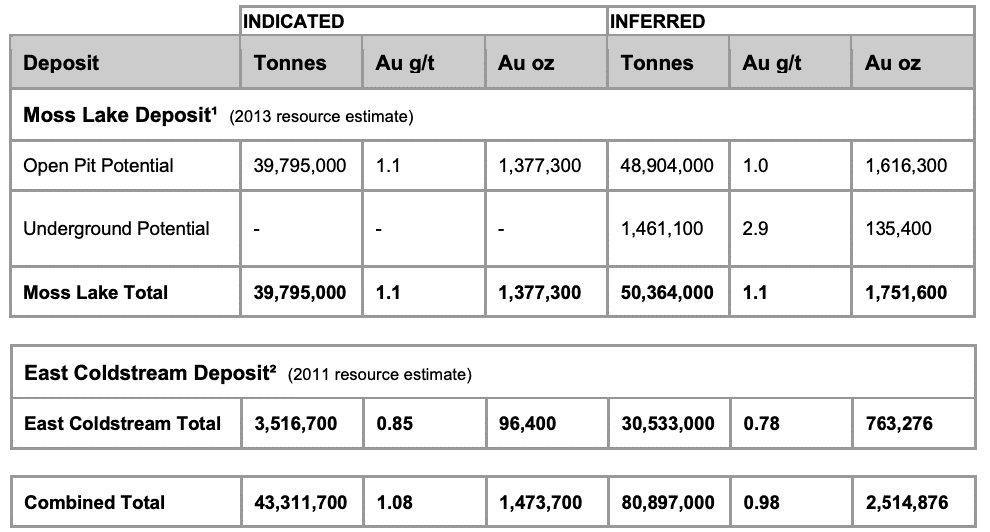
Notes:
(1) Source: Poirier, S., Patrick, G.A., Richard, P.L., and Palich, J. “Technical Report and Preliminary Economic Assessment for the Moss Lake Project”, prepared for Moss Lake Gold Mines Ltd. The qualified persons for the Moss Lake Historical Estimate are Pierre-Luc Richard, MSc, PGeo (InnovExplo Inc), and Carl Pelletier, BSc, PGeo (InnovExplo Inc), and the effective date of the Moss Lake Historical Estimate is February 8, 2013. In-Pit results are presented undiluted and in situ, within Whittle-optimized pit shells. Underground results are presented undiluted and in situ, outside Whittle-optimized pit shells. The Moss Lake Historical Estimate includes 18 gold-bearing zones and 1 envelope containing isolated gold intercepts. Whittle parameters: mining cost = C$2.28; pit slope angle = 50.0 degrees; production cost = C$9.55; mining Dilution = 5%; mining recovery = 95%; processing recovery = 80% to 85%; gold price = C$1,500. In-Pit and Underground resources were compiled at cut-off grades from 0.3 to 5.0 g/t Au (for sensitivity characterization). A cut-off grade of 0.5 g/t Au was selected as the official in-pit cut-off grade and a cut-off grade of 2.0 g/t Au was selected as the official underground cut-off grade. The Moss Lake Historical Estimate is based on 352 diamond drill holes (90,978 m) drilled from 1983 and 2008. A fixed density of 2.78 g/cm3 was used. A minimum true thickness of 5.0 m was applied, using the grade of the adjacent material when assayed or a value of zero when not assayed. Capping was established at 35 g/t Au, supported by statistical analysis and the high grade distribution within the deposit. Compositing was done on drill hole sections falling within the mineralized zone solids (composite = 1 m). Resources were evaluated from drill hole samples using the ID2 interpolation method in a multi-folder percent block model using Gems version 6.4. Based on geostatistics, the ellipse range for interpolation was 75m x 67.5m x 40m. The Indicated category is defined by combining the blocks within the two main zones and various statistical criteria, such as average distance to composites, distance to closest composite, quantity of drill holes within the search area. Ounce (troy) = metric tons x grade / 31.10348. Calculations used metric units (metres, tonnes and g/t). The number of metric tonnes was rounded to the nearest thousand. Any discrepancies in the totals are due to rounding effects; rounding followed the recommendations in NI 43-101.
(2) Source: McCracken, T. “Technical Report and Resource Estimate on the Osmani Gold Deposit, Coldstream Property, Northwestern Ontario”, prepared for Foundation Resources Inc. and Alto Ventures Ltd. The East Coldstream Historical Estimate is based on a 0.4 g/t Au cut-off grade. The qualified persons for the East Coldstream Historical Estimate are Todd McCracken, P.Geo. (Tetratech Wardrop), and Jeff Wilson, Ph.D., P.Geo. (Tetratech Wardrop), and the effective date of the East Coldstream Historical Estimate is December 12, 2011. Resources are presented unconstrained, undiluted and in situ. The East Coldstream Historical Estimate includes 2 gold-bearing zones. A cut-off grade of 0.4 g/t Au was selected as the official resource cut-off grade. The East Coldstream Historical Estimate is based on 116 diamond drill holes drilled from 1986 to 2011. A fixed density of 2.78 g/cm3 was used. Capping was established at 5.89 g/t Au and 5.70 g/t Au for domains EC-1 and EC-2, respectively. This is supported by statistical analysis and the high grade distribution within the deposit. Compositing was done on drill hole sections falling within the mineralized zone solids (composite = 1 m). Resources were evaluated from drill hole samples using the ID2 interpolation method in a multi-folder percent block model using Datamine Studio 3 version 3.20.5321.0. Recource categorization is based on spatial continuity based from the variography of the assays within the drillholes. Ounce (troy) = metric tons x grade / 31.10348. Calculations used metric units (metres, tonnes and g/t). The number of metric tonnes was rounded to the nearest thousand. Any discrepancies in the totals are due to rounding effects; rounding followed the recommendations in NI 43-101.
(3) The reader is cautioned that the Moss Lake Historical Estimate East and the East Coldstream Historical Estimate are considered historical in nature and as such is based on prior data and reports prepared by previous property owners. The reader is cautioned not to treat them, or any part of them, as current mineral resources or reserves. The Company has determined these historical resources are reliable, and relevant to be included here in that they demonstrate simply the mineral potential of the Moss Lake Gold Project. A qualified person has not done sufficient work to classify the Historical Estimates as current resources and Goldshore is not treating the Historical Estimates as current resources. Significant data compilation, re-drilling, re-sampling and data verification may be required by a qualified person before the Historical Estimates can be classified as a current resource. There can be no assurance that any of the historical mineral resources, in whole or in part, will ever become economically viable. In addition, mineral resources are not mineral reserves and do not have demonstrated economic viability. Even if classified as a current resource, there is no certainty as to whether further exploration will result in any inferred mineral resources being upgraded to an indicated or measured mineral resource category. The Historical Estimates relating to inferred mineral resources were calculated using prior mining industry standard definitions and practices for estimating mineral resource and mineral reserves. Such prior definitions and practices were utilized prior to the implementation of the current standards of the Canadian Institute of Mining for mineral resource estimation, and have a lower level of confidence.
Table 4: Reported Historical Production from the North Coldstream Deposit ⁴

Note:
(4) Source: Schlanka, R., 1969. Copper, Nickel, Lead and Zinc Deposits of Ontario, Mineral Resources Circular No. 12, Ontario Geological Survey, pp. 314-316.
Peter Flindell, P.Geo., MAusIMM, MAIG, Vice President – Exploration of the Company, a qualified person under NI 43-101 has approved the scientific and technical information contained in this news release.
MORE or "UNCATEGORIZED"
Kuya Silver Confirms High-Grade Silver-Gold Vein Mineralization at Umm-Hadid with Initial Drill Results up to 1483.9 g/t AgEq over 2 Metres
Kuya Silver Corporation (CSE: KUYA) (OTCQB: KUYAF) (FSE: 6MR1) is... READ MORE
First Phosphate Closes Final Tranche of Oversubscribed Private Placement
First Phosphate Corp. (CSE: PHOS) (OTCQX: FRSPF) (FSE: KD0) is... READ MORE
GFG Receives Final Payment from the Sale of its Rattlesnake Hills Gold Project
GFG Resources Inc. (TSX-V: GFG) (OTCQB: GFGSF) announces that i... READ MORE
Goliath Receives $1,730,882 Through Warrant Exercises, Inclusive Of Crescat Capital A Longtime Strategic And Cornerstone Shareholder
Goliath Resources Limited (TSX-V: GOT) (OTCQB: GOTRF) (FSE: B4IF)... READ MORE
Robex Pours First Gold at Kiniéro on Schedule and Budget
Highlights: Gold bar weighing 2.64 kilograms (85 oz) poured in th... READ MORE












